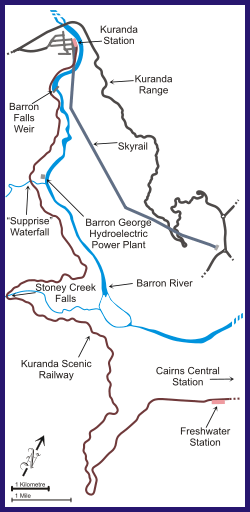Kuranda Scenic Railway
The Kuranda Scenic Railway is the name for the railway line that runs from the coastal city of Cairns, Queensland, Australia, over the Great Dividing Range to the town of Kuranda on the Atherton Tableland. The tourist railway snakes its way up through the Macalister Range on the Cairns-to-Kuranda railway line which is no longer used for regular commuter services, but instead operates as a tourist service, operating every day of the year, except Christmas Day. It passes through the suburbs of Stratford, Freshwater (stopping at Freshwater railway station) and Redlynch before reaching Kuranda. The line is used for some freight services and other passenger services, such as The Savannahlander.
 | |
Kuranda railway station | |
| Overview | |
|---|---|
| Headquarters | |
| Locale | Kuranda |
| Dates of operation | 1891–present |
| Technical | |
| Track gauge | 1,067 mm |
| Length | 37 km (23 mi) |
| Other | |
| Website | www |
The railway is 37 km (23 mi) in length.[1] It takes about one hour and 55 minutes to climb one way including the stop off at the falls.[2]
Attractions
The tropical gardens Kuranda rail station are a well-known attraction in the area. Downhill the line cuts through the Barron Gorge National Park. The tourist train stops at a lookout, with a sweeping view of Barron Falls. A number of smaller waterfalls are passed, including Stoney Creek Falls, just metres from the train. The station is a short walk into town where there is a zoo, markets, art galleries and ethnic Aboriginal crafts. In the zoo, there is the option to hold a koala and feed kangaroos, a true Australian experience. At the bottom of the mountain, where many people pick up the train, Freshwater railway station has an information center, a gift shop, and a cafe that is inside of an old train carriage. As the train travels up and down, a detailed and informative commentary of the railway's construction is provided.
History

Construction of the railway began in 1886.[3] The railway was completed as far as Kuranda in 1891. Passenger services began operations on 25 June 1891.[4]
Many lives were lost as numerous tunnels and bridges were built. 15 hand-made tunnels and 37 bridges were built to climb from sea level to 328 metres up the Macalister Range.[3] Three million cubic metres of earth had to be excavated during construction.[1]
The first operation of a tourist train from Cairns to Kuranda was in 1936, using four longitudinal seating carriages.[5] In 1995 major repairs had to be carried out after a severe rock fall damaged the track. On 26 March 2010 the train was derailed by a landslide injuring 5 of the 250 passengers on board.[6] The service was closed until 7 May 2010 while a geotechnical review of the track and risk assessments were completed.[7]
Carriages
There are two gold class carriages where refreshments and finger food are served on the journey. In the standard carriages there are two booths that face each other which create a section, and there are five of these sections in each carriage. The carriages are very rustic and have been restored to look like the original ones, the wood work is very detailed and everything about the carriage is like being sent back in time. Although the red leather seats can become very hot and the breeze in the train is very minimal, the carriages are quite impressive. [8]
Awards
In 2009 as part of the Q150 celebrations, the Kuranda Scenic Railway was announced as one of the Q150 Icons of Queensland for its role as a "structure and engineering feat".[9]

References
- "Kuranda Scenic Railway celebrates 120 years". The Cairns Post. News Limited. 21 June 2011. Archived from the original on 18 April 2012. Retrieved 24 April 2012.
- ""Kuranda Scenic Railway Timetables". Kuranda Scenic Railway. Archived from the original on 4 November 2015. Retrieved 23 October 2015.
- ""Money will force a Railway anywhere...": construction of the Cairns-Kuranda railway line, 1886-1892". Lectures on North Queensland history. No. 5 chapter 6 pp. 122-141. James Cook University of North Queensland, Townsville, Qld. Archived from the original on 12 May 2018. Retrieved 23 October 2015.
- "Skyrail Rainforest Cableway and Kuranda Scenic Railway - Cairns". RACQ. Archived from the original on 28 May 2012. Retrieved 24 April 2012.
- The Kuranda Tourist Train in 1991 Beckhaus, John Australian Railway Historical Society Bulletin, December 1992 pp283-299
- (26 March 2010). Kuranda train derails near Redlynch Archived 1 July 2010 at the Wayback Machine. The Cairns Post. News Limited. Retrieved on 24 April 2012.
- Stephanie Harrington (7 May 2010). Kuranda Scenic Railway rides again Archived 16 March 2011 at the Wayback Machine. The Cairns Post. News Limited. Retrieved on 24 April 2012.
- Kuranda Scenic Railway - 030_Tour options - Gold Class Archived 19 November 2007 at the Wayback Machine
- Bligh, Anna (10 June 2009). "PREMIER UNVEILS QUEENSLAND'S 150 ICONS". Queensland Government. Archived from the original on 24 May 2017. Retrieved 24 May 2017.
External links
| Wikimedia Commons has media related to Kuranda Scenic Railway. |
- Kuranda Scenic Railway
- Cairns museum Cairns-Kuranda Railway Construction
- Google Earth .kml that shows track of the skyrail as well as railway between Cairns and Kuranda.